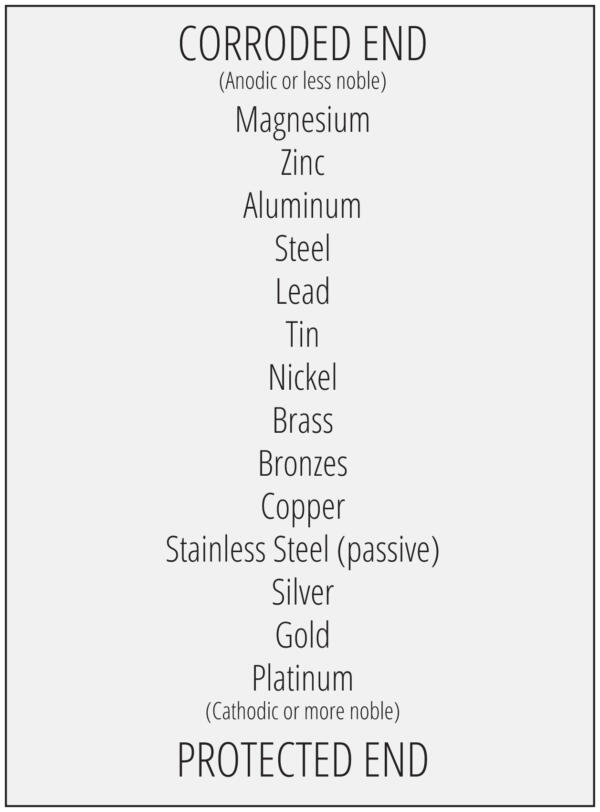What is Cathodic Protection?
Explaining some of the benefits of hot-dip galvanized steel to a customer has the possibility of raising more questions than answers. For example, discussing the benefits of barrier protection as a corrosion controller proves to be a much simpler task than explaining the benefits of cathodic protection; a complicated subject that requires a more technical answer. This article concisely answers the question, What is cathodic protection and how does it apply to hot-dip galvanized steel? Hopefully, it will help inform specifiers and customers alike of the processes and benefits of cathodic protection supplied by galvanized steel.

Galvanic reactions cause most of the observed corrosion of materials in the environment. The presence of four necessary components creates a galvanic cell through natural thermodynamic processes: an anode, a cathode, an electrolyte, and a return path for an electrical current. Finding all four of the necessary components together seems like an almost impossible task, but in reality, these cells are very common and cause most of the corrosion we see around us. A simple example can be seen in a design consisting of two dissimilar metals in contact. When this occurs, one acts as an anode, and the other as a cathode. Each metal's position in the Galvanic Series (Figure 1) determines whether it will be the cathode or the anode in this system.
The corrosion process consumes only the metal of the anode. The anode sacrifices itself first to corrosion, preserving the cathode until the anode is fully consumed. The overlapping area creates a return current path, and the air surrounding the metals acts as an electrolyte. Therefore, all four elements of the galvanic cell are in place and only the anode begins to corrode at an accelerated rate. In applications such as these, separating the two metals with an insulating material, such as rubber, solves the problem of galvanic corrosion.
However, not all galvanic cells are destructive accidents. Galvanic cells can be created to purposefully and successfully protect a material from corroding. Once again, in this system, only the anode is consumed through corrosion processes. This fact is used advantageously to control corrosion and protect our structures and investments. Creating a new galvanic cell, in which a material more anodic to the material to be protected is introduced ensures corrosion will take place on the new anode and not the valuable protected cathode.
This new material is called the sacrificial anode and is thus the key to cathodic protection. As with other forms of galvanic corrosion, the four essential elements discussed earlier must be present and functioning to properly achieve cathodic protection. When black steel is exposed to the atmosphere, small regions on the surface of the steel act as anodes and surrounding regions act as cathodes. This process eventually causes the entire surface to rust and corrode. The introduction of a sacrificial anode into the system stops this process and forces the steel to act as one large, corrosion-free, cathode rather than a system of smaller cathodes and anodes. The sacrificial anode being consumed through this controlled corrosion protects the steel and your investment.
In the case of hot-dip galvanized steel, a sacrificial anode is introduced by coating the steel in zinc. The zinc acts as an anode, the steel as a cathode, and the metallurgical bond between the two creates a return current path. A deep scratch in the surface of the zinc will expose the underlying bare steel. When a scratch exposes the base steel, atmospheric, soil, or submerged conditions offer an electrolyte between the zinc and the newly exposed steel, completing the circle and adding the fourth element for a complete galvanic cell. In this galvanic cell, the base steel is protected and the zinc coating is consumed. Even when the coating is scratched, and up to 1/4-inch of bare steel is exposed, the zinc will protect the steel from rusting.
While paint may form blisters after being scratched, hot-dip galvanized steel uses the added benefit of cathodic protection to remain corrosion free for an extended amount of time. Cathodic protection also protects ends of pieces that may be exposed from cutting the steel after galvanizing. While this article may not answer all of the questions posed about cathodic protection, enough information is presented to help explain how cathodic protection benefits hot-dip galvanized steel. Working in combination with the barrier of the zinc coating, cathodic protection keeps your valuable steel structurally sound and helps provide many years of service.
© 2025 American Galvanizers Association. The material provided herein has been developed to provide accurate and authoritative information about after-fabrication hot-dip galvanized steel. This material provides general information only and is not intended as a substitute for competent professional examination and verification as to suitability and applicability. The information provided herein is not intended as a representation or warranty on the part of the AGA. Anyone making use of this information assumes all liability arising from such use.

